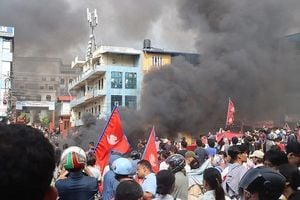In a dramatic escalation of the ongoing conflict between Ukraine and Russia, Ukrainian drones struck one of Russia's most critical energy assets early Sunday, October 19, 2025. The Orenburg gas processing plant, located near the Kazakh border and operated by state-owned energy giant Gazprom, was hit in a targeted attack that ignited a fire and forced the facility to suspend its intake of natural gas from Kazakhstan. The strike, confirmed by multiple official sources and widely reported by international media, marks the first known assault on this particular plant—one of the largest of its kind in the world, with an annual processing capacity of 45 billion cubic meters.
Kazakhstan’s Ministry of Energy announced the suspension, stating that Gazprom had notified them of an “emergency situation” following the drone attack. The Orenburg plant plays a pivotal role, processing gas condensate from Kazakhstan’s Karachaganak field as well as from Russia’s own Orenburg oil and gas fields. According to regional governor Yevgeny Solntsev, the drone strikes set fire to a workshop at the facility and caused partial damage to the plant. The fire was later extinguished, but the full extent of the damage and the timeline for resuming operations remain unclear, as Gazprom has yet to release further details. Thankfully, no casualties have been reported.
Ukraine’s General Staff issued a statement Sunday, reporting a “large-scale fire” at the Orenburg plant and damage to one of its gas processing and purification units. The Ukrainian military confirmed it had also struck an oil refinery in Russia’s Samara region, highlighting a broader campaign to disrupt Russia’s energy infrastructure. As reported by AP and CBC, these attacks are part of a wider Ukrainian strategy aimed at undermining Russia’s ability to fund and fuel its war effort. Since August, Ukraine has ramped up its assaults on Russian refineries and energy facilities, targeting at least 18 oil installations. These strikes have caused significant disruptions, including the shutdown of a key oil terminal in Crimea and a notable drop in Russia’s fossil fuel exports—the lowest since the war began nearly four years ago.
Ukrainian President Volodymyr Zelensky has been vocal about the effectiveness of these tactics. He described the attacks on Russian oil refineries, depots, and terminals as “the most effective sanctions—the ones that work the fastest.” Zelensky also echoed calls for NATO members to halt purchases of Russian oil, urging the West to sever its dependence on Moscow’s energy. “The signals from America are clear—they are ready to supply as much gas and oil as needed to replace Russian supplies. Our region has the necessary infrastructure and potential to contribute to Europe’s energy independence way more,” Zelensky said, as cited by New York Post and AP.
In the wake of the Orenburg strike, Russia’s Ministry of Defense reported a massive overnight drone assault, claiming to have shot down at least 45 Ukrainian UAVs. These included 12 over the Samara region, 11 over Saratov, and one over Orenburg. Ukraine’s air force, for its part, stated that Russia had launched 62 drones into Ukrainian territory during the same period, with 40 being intercepted or diverted by electronic jamming. The governor of Russia’s Samara region, Vyacheslav Fedorishchev, reported that air defenses were active overnight, and as a precaution, the local airport and mobile internet services were temporarily suspended.
Drone warfare has rapidly become a defining feature of the conflict, with both sides deploying unmanned aerial vehicles to strike deep behind enemy lines. The Orenburg attack is emblematic of Ukraine’s evolving military tactics, which now focus on undermining Russia’s economic and logistical backbone. As CBC noted, this was the first reported strike on the Orenburg gas plant, a facility integral to both Russian and Kazakh energy networks. The plant’s partial shutdown and the suspension of Kazakh gas intake underline the far-reaching consequences of the drone campaign—not just for Russia, but for its regional partners as well.
Meanwhile, the political landscape surrounding the conflict is shifting. U.S. President Donald Trump, in a Fox News interview aired Sunday but conducted prior to recent meetings with Russian President Vladimir Putin and Ukrainian President Zelensky, suggested that Kyiv may ultimately have to consider ceding territory in exchange for peace. “Well, he’s going to take something,” Trump said, referring to Putin and the land currently occupied by Russian forces. “They fought and he has a lot of property. He’s won certain property. We’re the only nation that goes in, wins a war and then leaves.” Trump’s comments mark a notable shift in U.S. rhetoric, coming after weeks of expressing growing impatience with Putin and signaling more openness to aiding Ukraine. However, when pressed about sending Tomahawk missiles to Ukraine—a move that could dramatically alter the military balance—Trump was noncommittal: “I’m looking at it,” he said, citing concerns about depleting U.S. weapons stockpiles. “We need them for ourselves too. We can’t give all our weapons to Ukraine. We just can’t do that.”
Despite Kyiv’s hopes, Trump did not pledge to provide Tomahawks after his meeting with Zelensky at the White House. Military analysts, as reported by AP, suggest that such advanced weapons could give Ukraine the leverage needed to bring Russia to the negotiating table, especially as Putin remains steadfast on key issues. For now, Ukraine’s arsenal remains limited to shorter-range systems, constraining its ability to strike targets deep inside Russian territory.
On the ground, the war continues to take a heavy toll. Ukrainian prosecutors have accused Russia of modifying its aerial-guided bombs to reach deeper into Ukrainian territory. In Kharkiv, local authorities said Russia used a new rocket-powered aerial bomb, the UMPB-5R, for the first time in an attack on the city of Lozava, some 150 kilometers south of Kharkiv. The bomb, capable of traveling up to 130 kilometers, represents a worrying escalation in Russia’s ability to strike civilian areas far from the front lines. Elsewhere, Russian drone attacks in the Dnipropetrovsk region left at least 11 people injured and damaged multiple residential buildings and a store. A separate Russian strike hit a coal mine, but all 192 miners were safely evacuated.
As both sides intensify their use of drones and long-range weaponry, the war’s front lines are becoming increasingly blurred. Civilian infrastructure—energy plants, refineries, residential neighborhoods—has become a primary target, raising the stakes for all parties involved. The Orenburg gas plant attack underscores the vulnerability of even the most fortified facilities and signals that the conflict is far from over.
With Ukraine vowing to continue its campaign against Russian energy assets and Western leaders debating the next steps, the region faces an uncertain future. The latest strikes and political maneuvers suggest that, for now, neither side is ready to back down, and the prospect of a negotiated peace remains elusive.





